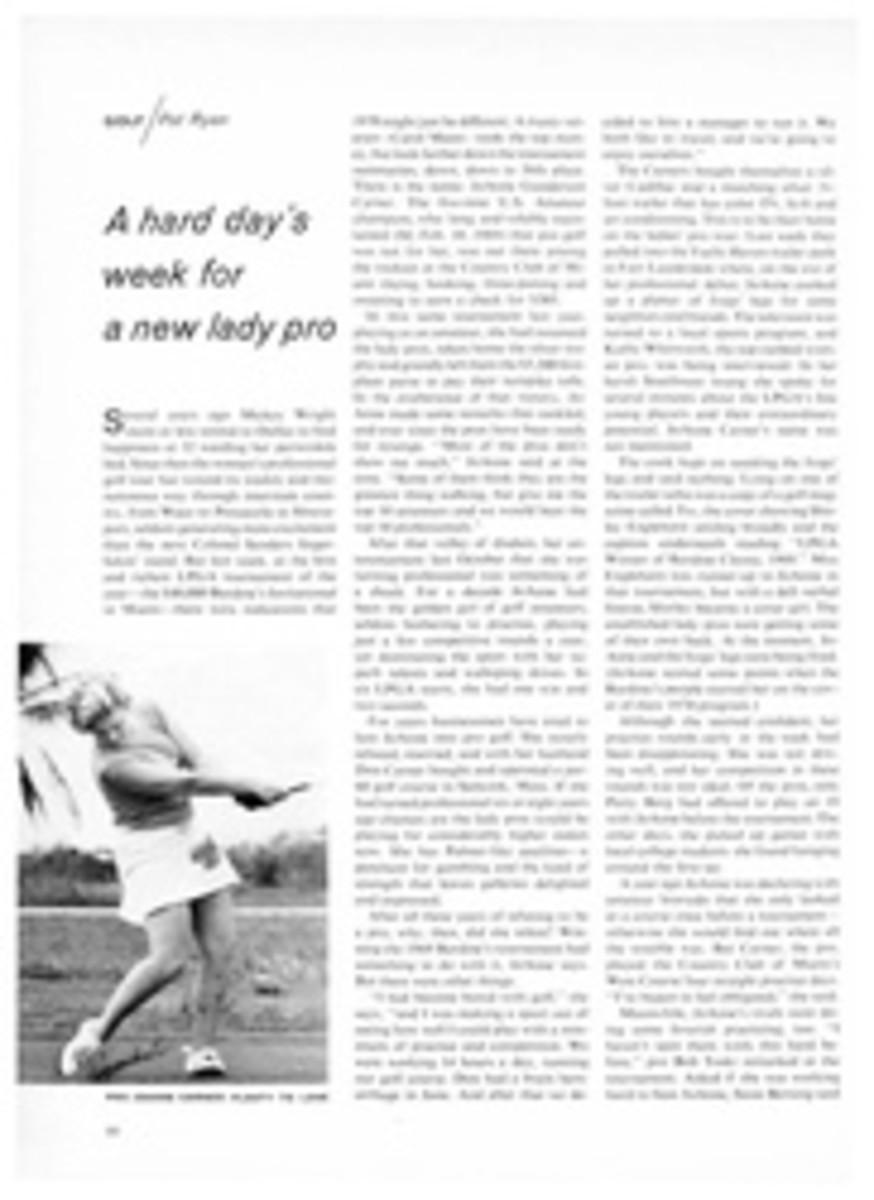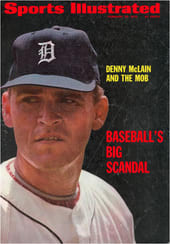
SCORECARD
THE McLAIN AFFAIR
The unhappy revelation that Pitcher Denny McLain was a partner in a bookie operation dominated by mobsters (page 16) is not a story we take pleasure in printing. Professional sport lives on the confidence of its audience, and exposing ugly facts may momentarily shake that confidence; but trying to hide them would destroy it.
A professional athlete can be a swinger, let his hair grow in profusion, wear wild clothes, do his own thing, flout staid and established conventions. But through it all, if he is to maintain his authority as an athlete, he can never forget his responsibility to his job—to his club, to his teammates, to his game. To some this may seem naive, old fashioned and square. Too bad. That's the way it is.
RUMBLING TOWN
Chicago's high school athletic association is in danger of dissolving in a welter of brawls, disturbances and postgame riots. The 55-member league has had trouble finding a place to hold its basketball playoffs. DePaul University and Northwestern won't allow their gyms to be used because of disturbances in recent years, and Illinois Tech and the University of Chicago balked, too. The International Amphitheater doesn't have available dates, and the Chicago Stadium rental of $5,000 per day is too costly. School officials finally settled for the old Navy Pier gym, where the games will be played under police guard before a screened crowd.
One bright spot in the gloomy picture came when Farragut met Crane Tech in a critical game. Just before the opening whistle Guido Marchetti, the Farragut football coach and athletic director, walked to center court and blew a whistle for silence. The kids yelled and hooted and grumbled before they slowly quieted down. When he finally had their attention Marchetti said, "You know what's been going on in this league. If it continues, we may not have any sports in this league in the future. If you don't behave like ladies and gentlemen today we will not allow spectators in this gym for any game the rest of the season. It's entirely up to you."
He marched off. The kids cheered and applauded. And there were no incidents during or after the game.
PRIME TIME
One interscholastic sport you may not be following closely is meat judging, which is promoted by the National Livestock and Meat Board in Chicago. The board annually sponsors four meat-judging contests for collegians, with the big one held at the end of the year. Contestants are usually animal-science majors (including girls) who plan to become meat buyers, research specialists with meat-packing plants or teachers. Winners usually do very well in industry after graduation.
The judges, who are animal-science professors, meat packers and specialists from the Department of Agriculture, secretly grade carcasses and wholesale cuts of beef, pork and lamb according to Department of Agriculture standards: prime, choice, good, etc. They also rate them for "cutability," the yield of lean meat that might be expected from each carcass. The contestants are then let loose on the meat, and those whose classifications come closest to those of the judges carry home the bacon.
The International Livestock Exposition's Intercollegiate Meat-Judging Contest, held at the Oscar Mayer plant in Madison, Wis. in December, attracted four-man teams from 22 colleges, and excitement mounted as Nebraska went to the front in lamb and pork judging. Kansas State made a bid for the title, showing balanced power in lamb and beef, but it did not do so well in hams, and Oklahoma State came on to win the overall title, with Florida second and K State third. Something of an upset occurred in beef grading when South Dakota State finished strongly to beat out several larger schools.
You might do some boning up on this pastime. It's liable to appear on Wide World of Sport any week now.
FLYING LONGHORNS
"Hook 'em, Horns" has long been the battle cry of University of Texas football fans, who look upon Longhorn teams with something akin to reverence. Thus it was no surprise when on the new airplane the school bought to shuttle its administrators around the state, in place of the standard admonition to FASTEN SEAT BELTS there was the simple reminder: HOOK 'EM.
SPREADING OUT
The Carolina Cougars, the ABA franchise in North Carolina (SI, Jan. 19), may have started a trend with their successful practice of spreading home games around among various cities in the state. The Miami Floridians, who have had trouble finding a suitable home arena in the Miami area, have shifted a couple of home dates this season to Tallahassee and Jacksonville and next year hope to play 10 home games in Jacksonville, 10 in St. Petersburg and only 20 in Miami. "For one thing," says Dennis Murphy, a vice-president of the Floridians, "it will be easier to sell a season-ticket plan for 10 or 20 games than for 40." The New Orleans Bucs, another ABA club with attendance problems, may be transferred to Memphis, but if the club stays in New Orleans it will almost certainly play a dozen home games in Baton Rouge, another half a dozen in Shreveport and a few others in Lafayette and Alexandria. Maurice Stern, co-owner of the Bucs, says, "A lot of people feel that New Orleans is a football town and that 40 basketball games are too many to play here. And those other towns have better field houses and parking than we have here."
NEW SHOES
After the shoe scandals at the Mexico City Olympic Games (SI, March 10, 1969), the International Amateur Athletic Federation moved to eliminate undercover payments to athletes for wearing the distinctively marked shoes of one company or another by passing a rule that bans all such colors or markings on shoes worn at international meets. Only all-white shoes will be allowed. The rule, passed last year, goes into effect this May 1, but some athletes have declared flatly that they will not obey it. One is Australia's Ralph Doubell, the 1968 Olympic 800-meter champion, who says, "I will show up at the meets wearing the kind of shoes I have always worn. If they won't let me race in them, then I expect I will run some pretty slow times in my bare feet." Some black athletes object to the new rule, too, though on different grounds. They say they will run in all-black shoes, not all-white ones.
BÉISBOL IN CUBA
Preston Gomez, manager of the San Diego Padres, made a three-week trip to his native Cuba this winter to visit his ailing father and to bring his elderly mother back to the U.S. for a visit (a naturalized citizen, he had Cuban permission and State Department approval and flew to and from Havana via Mexico City). Although his visit was ignored by the Cuban press ("I am a professional manager and therefore not worthy of notice"), he attracted considerable attention among baseball-hungry Cubanos. He spoke at three baseball clinics and was able to talk about old times with former major leaguers like Mike Gonzalez, Mike Guerra, Gil Torres and Connie Marrero, as well as with Martin Dihigo, past 65 now and, Gomez says, "the greatest Cuban player."
One day Fidel Castro came into the Havana restaurant where Gomez was dining, joined him and talked baseball for two hours. He was particularly interested in the Cubans still playing in the U.S. "He knew all the names," says Gomez. "He asked about Tony Oliva, José Cardenal, Tito Fuentes, Zoilo Versalles, Cookie Rojas, Tony Taylor, Mike Cuellar." Castro also asked Gomez his opinion of the current state of baseball in Cuba. "I told him there were advantages and disadvantages," Gomez says. "You never lose any ballplayers to the big leagues, but the players reach only a certain level. They have no higher place to go." Castro appeared to be concerned that Cuban players were falling behind in fundamentals and, according to Gomez, the government sends people to Canada to watch big league baseball on television "in order to learn what we are doing."
SIX CENTS WORTH OF COACH
When Lawrence Central High School of Indiana lost its 36th straight game an exasperated fan wrote to the Lawrence Journal complaining that as a taxpayer who was helping to pay Coach Woodrow Crum's salary he didn't think he was getting his money's worth. Crum, who coached high school teams in Kentucky to the state finals three times before moving to Lawrence Central a few years ago, responded by dividing the number of taxpayers in Lawrence into his salary and then refunding the angry fan his share: 6¢. "It was just something I had to do," said Crum, whose team reacted by breaking the losing streak next time out.
DIRTY STORY
The nation's 10 dirtiest streams, according to the Federal Water Pollution Control Administration, are the Ohio, the Houston Ship Canal, the Cuyahoga (Cleveland's burning river), the River Rouge near Detroit, the Buffalo, the Passaic in New Jersey, the Arthur Kill between Staten Island and New Jersey, the Merrimack (New Hampshire and Massachusetts), the Androscoggin in Maine and the Escambia in Alabama and Florida. This is a particularly choice group, since such befouled rivers as the Hudson, the Potomac, the Mississippi, the Missouri and the Connecticut are down in the second 10. Asked to name a clean major river, the federal officials shook their heads. There is none.
There are some mighty colorful rivers, too. The algae-thick Potomac is blue-green. The Delaware is black with oil. Many Southern rivers are white from the milky wastes pouring out of textile and carpet mills. The headwaters of the Monongahela are yellow from mine acid. The Clarion River in Pennsylvania is a rich inky blue because of wastes from a printing plant. And there are multicolored waters like Lake Erie and the Calumet River near Chicago.
The Ohio continues as the country's dirtiest river despite the nearly $1 billion spent cleaning it up during the last 20 years. There are 38,000 industrial plants in the Ohio's 10-state drainage area, and industry is the prime cause of water pollution. Correcting the situation is difficult. One federal official said, "Industry can be politically potent, especially at the state-government level. And, too, the states compete with one another for new industry, because new industry means jobs, and the states generally need that economic stimulus. They are more scared of driving industry away than they are of water pollution."
And so goes the beautiful blue Ohio.
...AND COUNTING
Here is a bit of esoteric data to tuck away until the opportunity arises to make a bet on the subject. Statistician Ron Morris of WSTP Radio says that during a basketball game in Salisbury, N.C. between Catawba College and Appalachian State the ball touched the floor precisely 3,313 times.
ILLUSTRATION
THEY SAID IT
•Mike Reid, first-round draft choice of the Cincinnati Bengals, on why he is postponing a promising career as a pianist to play football: "Artur Rubinstein is recognized as the greatest pianist in the world, and he began to get acclaim at 55. There aren't any 55-year-old defensive tackles around."
•John Babcock, Los Angeles radio commentator: "Los Angeles has no right to seek the 1976 Olympics—no right because the world's best athletes should not be exposed to the poisonous smog."
•David Hoover, a University of Michigan freshman majoring in fisheries and wildlife, who moved six miles outside Ann Arbor to live in a tent, explaining why: "There, look at that chickadee. I don't know whether animals can be happy or not, but they make me happy. Things are always fine and happy out here. When I get to town the air stinks and the people don't smile."

